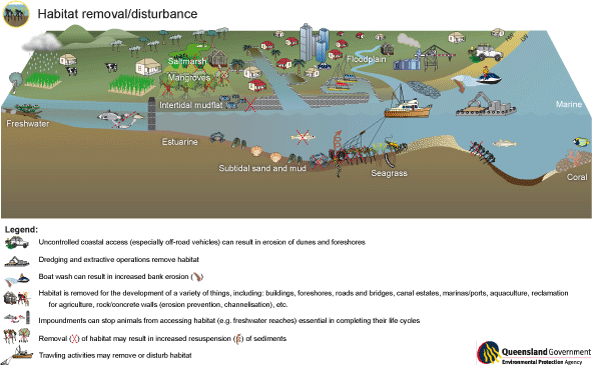Our current best conceptual understanding of the stressor ‘habitat removal/disturbance’ is shown in Figure 1.
Figure 1. Potential causes of a change to ‘habitat removal/disturbance’ and the condition responses observed as a result of this change.
Habitat loss and its effects on biodiversity is a growing global concern. Loss of habitat is a major cause of the decline of coastal species. These habitats support key communities within estuarine, coastal, and/or marine subsystems and have a high biodiversity, tourism, human use and conservation value. The health of coastal waterways depends on the maintenance of a diverse range of coastal habitat types.
This stressor includes both direct removal of areas of riparian or shoreline habitat and activities that disturb or damage habitat areas. Removal may occur for several reasons, including construction work, foreshore development, marine facilities, aquaculture and urbanisation, or for other reasons. Disturbance of habitat includes things such as anchor damage, bank or beach erosion as a result of boat or vehicle use (causing instability in the underlying soils), oil spills, changes in sedimentation resulting in smothering, shading, etc. Habitat damage may also be caused by natural events, particularly storms, but these are not considered here. The potential impacts of negative changes in habitat include erosion, sediment deposition, poor water quality (particularly turbidity), loss of habitat-dependent species, and a loss in visual amenity.
Important habitats include:
- coastal floodplains;
- saltflats, saltpans;
- saltmarshes;
- mangroves;
- seagrasses;
- intertidal mud and sand substrates;
- subtidal mud and sand substrates;
- rocky shores and rock reefs;
- coral reefs;
- beaches and dunes;
- coastal cliffs and cliff-top communities; and
- water column.



